Marketing Strategy Evaluation at Bentley Motors
Introduction
The subsequent research report has been formulated from the perspective of a newly appointed Assistant Marketing Manager in the British luxury vehicles manufacturing and marketing organisation, Bentley Motors Limited (BML). The emphasis of the study report has been on the evaluation of the marketing essentials for the organisation under consideration and the assessment of various marketing functionalities which influence the business policies, procedures and product manufacturing at the BML. For those looking for guidance, marketing dissertation help can provide essential support in navigating these complexities.
The role of marketing and interrelationship with other functional units of Bentley Motors Limited
The objective of any organisational marketing is to focus completely on establishment of direct connection with existing customers (Kapferer and Valette-Florence, 2018, p.44). Such efforts are oriented towards personalisation of marketing experiences for the customers. Marketing teams, comprised by marketing agents, are provided leadership and guidance through leadership details such as marketing managers. Such leadership and guidance become vital to achieve success in implementation of marketing campaigns to create greater value for the investment by customers. Successful value creation for customers could provide the concerned business organisations with the ability to capture extensive value from the existing customers in the forms of greater sales volumes, increased profit margins and sustainable customer loyalty (Einwiller and Ruppel, 2015, p.220).
Interrelations with the Productions Department
For instance, the manufacturing and marketing of products by the BML depends upon the close coordination between the production and the marketing departments of the company. It is the process of gathering of information by the marketing department regarding the preferences, requirements and inclinations of the customers regarding vehicles, which, guides the production department to design and produce suitable products in the form of luxury vehicles for the customers (Madhani, 2017, p.21). The marketing department of BML is also responsible to conduct surveys about the expenditure capabilities of targeted customers, the purchase parity situation in the intended market segments, the value expectations and the quality measures in the finalised product offerings which could be appreciated by the customers. Such information is considered to be vital for the Production managers to maintain quality in increasingly price sensitive customer segments. Apart from these, marketing surveys could further inform the Production department of BML about the redundant features of the manufactured vehicles which have no value, in terms of customer preference generation, in the concurrent market scenario (Wilson, 2005, p.288). Such information contributes considerably in improving and upgrading the product offerings of BML. Finally, Have specified that the Marketing department of BML identifies the most promising customer segments where the manufactured luxury vehicles of the company could be sold to the optimised extent (Rahmani, Emamisaleh and Yadegari, 2015, p.107). This process involves the application of marketing campaigning based product differentiation efforts through which the Marketing department of the organisation highlights the most appealing features of the luxury vehicles manufactured by the Production department of the BML. Thus, the two functional units operate as complementary units for the functionalities of each other. Thus, the interrelationship between the Production and the Marketing departments of BML are dual fold. In case of the production management mechanism, the production capabilities regulate the number and types of luxury vehicles which could be marketed by the BML marketing department (Carlotto and O’Leary, 2018, p.206). On the other hand, accurate and precise sales forecast involving each type of product manufactured by the production system of the company essentially influence the product manufacturing line management since such forecasts establish the extent to which aggregate demand could exist for each type of luxury vehicle produced by BML.

Interrelations with the Human Resource Development Department
Furthermore, the BML Marketing Department is also assisted by the Human Resource Development Department (HRD) of BML to consistently develop productivity and accuracy in the designed marketing campaigns. This assistance is generated in the format of recruitment of experienced and promising human resources within the working structure of the company. The effective performance by the HRD department could furnish personnel to the Marketing department of BML to formulate strong marketing teams and the members of such teams could demonstrate extensive innovation in their marketing campaign designing approaches.
Interrelations with the Finance Department
Finally, the fundamental operational component in any business organisation is nothing else than finances. Thus, the Finance Department of BML plays a significant part in supporting the Marketing Department through the provisioning of necessary financial component to organise multimodal marketing campaigns. Such funding activity is oriented towards enabling the BML marketing teams to organise and manage the product packaging designs, logos, promotional events and product propagation related commercials which are associated with the campaigning and product differentiation process. The Marketing Department, in a comparable feedback loop, does provide the necessary information concerning the price ranges which are preferred by the customers of the company manufactured luxury vehicles throughout the targeted market segments. Moreover, the marketing approach to decisions involving financial offerings, at the BML, could offer new perspectives in product propagation and competitive leverage management which could not be, otherwise, available in the conventional financial management literature. These perspectives are as the following:
1: Annual financial reports utilisation to formulate particular methods of marketing communication for the customer communities.
2: Evaluation of customer responses concerning changes implemented in price ranges, methods of payments, credits and percentages of discounts.
3: Application of various indicators of financial performance concerning the purchase parity evaluation of relevant segments of markets where the BML could plan to sell the luxury cars.
4: Implementation of marketing impact assessment derived data to forecast the expectations of investors so as to determine the subsequent changes in the share prices of BML.
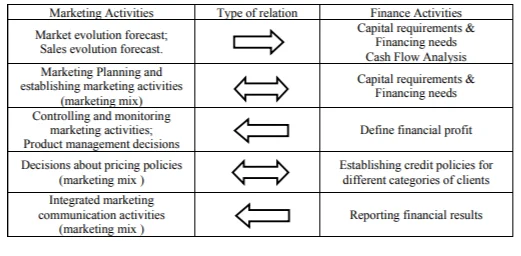
Compare ways in which organisations use elements of the marketing mix (7Ps) to achieve overall business objectives
Marketing mix of Bentley Motors Limited and market competitor Rolls Royce PLC
bentleymotors.com (2019) outlines that Bentley products generally consist of luxury vehicles which are offered to both the traditional aristocracy and the nouveau rich. The brand value is the strongest marketing tool for the BML vehicles. In this context, the salient features of the marketing mix based elements which outline the current marketing conditions of the BML products and the organisational objectives on which the marketing campaigns are stipulated (Loureiro and Kaufmann, 2016, p.117).
Looking for further insights on Marketing Strategy for SSE Metering? Click here.
Product
Most of the Bentley vehicle models are assembled and manufactured at the Crewe factory of the company. Only the Continental Flying Spurs is the product which is produced and assembled at the Dresden factory. Some components of the chases of the Continentals are manufactured at the Zwickau factory of BML at Germany (GIACOSA, 2016, p.25). On the other hand, Rolls Royce (RR) PLC offers premium products under 5 specific categories with different line of products including the Ghost, Wraith coupe, Dawn and the Phantom models. In this context, the product differentiation factors are emphasised as the primary factors for promoting the different categories and varieties of products of RR. The cars of RR exhibit the unique identity of long frontal bonnets, exteriors which have metallic finishing as well as interiors which are customised completely. Furthermore, RR also offers the convertible variation model or the Coupe model. The company strives to provide the ultimate luxurious standard regarding the automobile products. However, in a comparable measure of sales to Bentley, the annual sales globally, of the RR brand vehicles, are only estimated in between 3500 to 4000. According to Steenkamp (2017), the existing Bentley models of luxury vehicles could be identified as the following:
1:Bentley 4 ½ Litre
2:Bentley Turbo R
3:Bentley Speed Six
4:Bentley R-Type Continental
5:BentleyArnage
6:The Azure
7:BentleyBrookland
8:Continental Flying Spur
Some of these models could be identified to belong to the ‘Heritage Category’ which are the oldest of all of the Bentley models of cars (Begley, Collis and Donnelly, 2015, p. 602). These vehicles are valued to have most splendid finishing of handcrafted coach building chases and these models also include the best performance providing engines. Thus, the Heritage models determine the benchmark for the subsequent and new models which have so far been launched by the company under consideration. have identified the Bentley ‘Blue Train’, the Bentley Blower and the R-Type Continental to be some of the most valued and prestigious Heritage models of Bentley (Roberts and Armitage, 2015, p.44). Furthermore, has stated that some of the relatively new models of Bentley are the Continental Flying Spur, the Bentley Bentayga, the Continental GT and the Mulsanne (Noton, 2016, p.127). The production of previously well sought after Bentley Azure model of luxury vehicle had been discontinued during 2010. Out of all of such categories of Bentley products, the variety of models could be categorised to be four in number (GIACOSA, 2016, p.25). These are the Convertibles, the Coupe, the Sedan and the Sports Utility Vehicles (SUV).
Place
MAHMOUDIAN (2019) has elucidated that the majority of the products of BML are manufactured or assembled at the Crewe factory which is situated at the United Kingdom. The primary sales region of the luxury cars of the BML are Japan, UK, Canada, USA, Australia and China. At the Indian market also, Bentley has launched 12 different models of vehicle offerings out of which only one is an SUV model and the rest are categorised as the Sedan. Out of the gross manufacturing total of BML, an approximate 85% of all of the manufactured products are export versions for global markets (MAHMOUDIAN, 2019). Comparatively, the distribution strategy of RR completely depends upon the global presence of the company. The organisation currently holds offices throughout 50 countries and the customer base of the company is currently spread over 150 countries including the US, UK, India, Middle East, Australia, China and others. The company currently operates from the administrative and production centres situated at England. The limited client base has consistently contributed to the efforts of the company to develop an effective distribution network for the offered cars, for the spare parts and servicing facilities, which are, in many cases, delivered to the doorstep of the customers.
Price
Bentley concentrates on manufacturing of various ultra-high-end luxurious vehicles which are primarily meant to be bought by the wealthy customers (bentleymotors.com. 2019). Thus, the pricing strategy is greater oriented towards retention of a benchmark price which is comparatively higher than other vehicles currently being circulated in the markets. In a similar manner, the RR cars are also premium vehicles which are sold to the affluent and wealthy classes. The benchmark offering prices are always kept at a higher threshold since the company offers the customised products as per the required measures of the customers. In this context, the price measure of RR is greater than that of the Bentley, since the base price of the RR is $200,000- $250,000. The prices are generally increased through customisations, add-ons, interior furnishings and by other measures in accordance with the requirements of the customers. This process highlights the fact that RR is not disrupted by the competitive pricing elements and thus, could focus on the provisioning of the highest of qualities through premium pricing. Pardi (2015) has stated that Bentley Bentayga is currently rated as the most high priced and luxurious SUV model manufactured by BML. This is considered to be the most powerful one as well. In comparison to such highest pricing of the premium product of Bentley, the highest price of any RR offered branded car is that of $6 million (Hyperion Pininfarina model).
Promotions
Innovative approach based marketing campaigns are applied by Bentley to this purpose. Moon and Sprott (2016) have pointed out the method of printing of the official URL of the Bentayga SUV related information and sales portal on the initial, camouflaged test models of the vehicles when the production of SUV had been initiated. Such innovative marketing communication methods have so far ensured for the BML the garnering of maximised marketing coverage. On the other hand, the promotional effort of the Rolls Royce vehicles is premised upon the utilisation of the unconventional strategy of advertisements in the marketing mix policies. The niche segment of the market for which the cars are produced at the RR, prevents the company from utilisation of any mass media based advertisement channels such as the print media, the television or online advertisements. The brand identity is involved with luxury and the perceived social status of the owners. Thus, only the elitist segments of the societies, at the various sales destinations, tend to look for such a brand. The company utilises word of mouth and celebrity based advertising. Engaging the potential customers through various activities such as exclusive merchandising and expensive gift offerings are the preferred means of promotion for RR. Furthermore, the hosting of television shows and circulation of news paper articles are utilised to highlight the exclusivity of the offered merchandise as a means of PR coverage. The emphasis of Bentley is on the maintaining of the exclusivity of the products so that the brand integrity could as well be maintained. The organisation does not strive towards aggressive sales propagation at the absence of real demand in the existing markets. The 2008 economic downturn had contributed to the fall in sales of Bentley vehicles and the company has still pursued the conventional product marketing methods such as personal selling, public relations management, sales promotion and direct sales management through advertisements.
People
The Bentley workforce is primarily comprised of skilled craftsmen and technicians who are in possession of the cutting edge of automobile manufacturing technologies. The perception of the prestige of ownership of a Bentley luxury product at premium of prices is propagated through the marketing messages which encourage the sense of experiential, emotional and sensory fulfilment within the potential customers of the company. Other features of Bentley customers are as the following:
1: Mostly billionaires and super rich with dedication and passion of superior and prestigious living.
2: Inclination towards transforming pride into practice.
In case of the RR, the human resources are primarily associated with the sales team members who are tasked with the responsibility of management of marketing efforts for the brand. The sales personnel of RR are extensively versed in the persuasive techniques of sales propagation and this involves prioritization of the preferences of elite customers. Furthermore, the customer grievance redressing mechanisms of RR field some of the most experienced customer relationship management personnel of the organisation. The customers are required to contact these personnel in terms of their feedbacks concerning the issues in purchased products.
Process
Jedidi and Heil (2019) have observed that Bentley does not cater to the idea of lean manufacturing. Instead, the company actively encourages the participation of esteemed customers to add to the options which are infused in the vehicles during their design and manufacturing phases. Customers could prefer the colouring of their purchased cars in case that the colour combinations offered by Bentley could be excluded from their range of colour preferences. The customers could further select the car mats from the collections which are offered by Bentley. The company further offers the option of performing modifications on the basis of customer recommendations to specific components of the cars such as accessories, sizes of the motors and lights. The objective of such a process is to impart the sense to the customers that the Bentley is a unique vehicle with the customised characteristics which are reflective of the preferences of the customers only. The emphasis of the RR regarding the brand value propagation process is concentrated on the development of the most appealing car designs so as to add value to the product portfolio of the company. The objective is to impress the auto connoisseurs of UK and abroad. Thus, the process completely is incumbent upon the development of suave and modern designs of vehicles which could be identified with the identity perception of classical British aristocracy.
Physical evidence
The stores of the BML are utilised as the marketing tools to communicate the unique value of Bentley products to the wealthy classes who are viewed by the company management hierarchy as their traditional, affluent and class prestige conscious customers. The stores of BML are of particular significance in this perspective since these are considered as visual merchandising tools for the company (Hönig, 2019). The stores of BML are also considered to be the faces of the brand value attached to the company products. The store architectures are thus utilised to communicate such perceptions of brand value to the customers of Bentley products. The current distribution (regional) of the various numbers of stores of Bentley is as the following: 1: Total number of stores (globally):212 2: At UK: 24 3: AT USA: 38 4: At Europe: 52 5: Middle East and East Asia: 15 individually. Bentley intends to accelerate the organisational growth through leveraging the resources and engineering potentials of Volkswagen. This involves the inclusion of new electrified power trains and transmissions. On the other hand, Rolls Royce does not utilize the same engineering potential of the company which has acquired RR, the BMW. A scalable platform has been developed by the RR to be utilized for the future models including the Phantom and Project Cullinan, which has been planned by RR to be the first four wheeled utility vehicle of the company. While the objective of Bentley is to achieve the growth of sales to 20000 vehicles per annum, RR intends to remain exclusive regarding maintaining the current sales numbers to 6000 cars per annum. This presents the situation that while RR can opt to utilize marketing mix to utilization sharing of platforms with mass market brands regarding the benchmark threshold prices of $400000, Bentley has opted to occupy a specific market position where the offered Bentley products are positioning in between the highest priced cars of Mercedes Benzes and the least priced RR products.
Develop and evaluate a basic marketing plan
Mission statement: “To build a good car, a fast car, the best in class”. This statement had been coined by the co-founder of the company, Walter Owen Bentley.
Vision statement: “To the world in diverse and exciting ways”. Baltas and Saridakis (2010) have further observed that BML currently propagates the unstated organisational vision of being a definitive and deterministic British luxury vehicle brand which is dedicated towards development of the most desirable and high performance luxury cars through careful handcrafting. The company had been a subsidiary of the Volkswagen AG since the 1998. Prior to that, since the inception of the company in 1919 by H.M.Bentley, the company had been acquired by the Rolls-Royce Limited during 1931 and the Vickers PLC had acquired the company in 1980.
Tagline of Bentley: “The silent sports car”.
Marketing objectives
1: Obtaining a greater share in the existing luxury market.
2: Launching of new SUV models within the UK by 2020 which would be based on Porsche Cayenne models with a price tag of £140,000.
3: Greater emphasis on the eco-friendliness of the products.
Segmentation, Targeting and Positioning analysis
The BML brand has been utilising a combination of different psychographic and demographic strategies of market segmentation. The objective is to identify the various factors which could be utilised in the targeting strategy so that the passion and sense of prestige of the customers could be harnessed for the ultimate purpose of changing the existing status quo in terms of vehicle ownership. The targeting strategies employed by the BML are mostly exemplificative of the identified segments of customers in the concurrent markets. Selective targeting strategies are utilised by the company to deal with premium segments so that the products could be made appealing to the exclusive customers belonging to such a segment. The traditional owners of the Bentley luxury vehicles have been the experienced, glamorous, reserved, independent minded and wealthy British gentlemen (bentleymotors.com, 2019). Einwiller and Ruppel (2015) have been of the opinion that Bentley undertakes proper positioning of the entire product offering inventory through specifically communicating the value of the brand and the social elitist perceptions which are associated with Bentley luxurious vehicles.
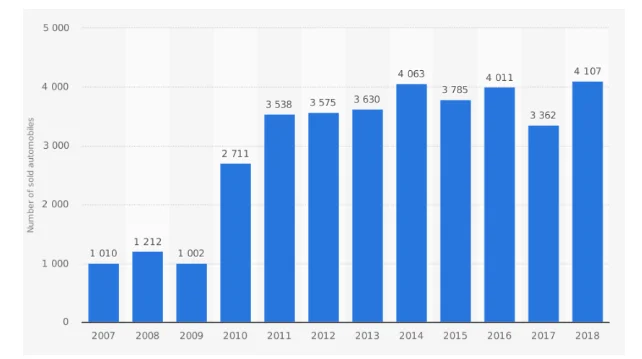
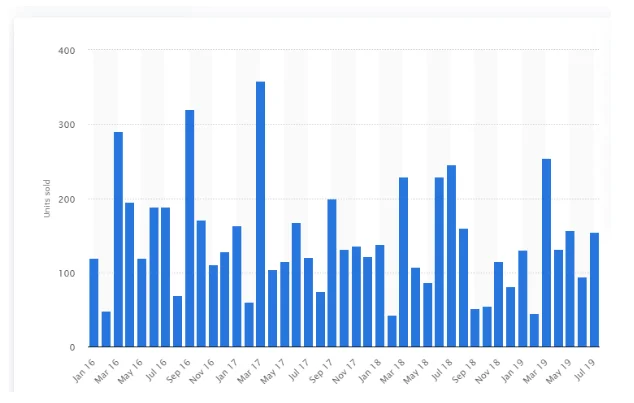
Market analysis
According to Steenkamp (2017), Bentley currently holds 37% of the share of super luxury vehicle and SUV market in terms of the total numbers of product sales. Out of the complete number of sold products, 51% of deliveries, on an average, are undertaken at European markets, 25% are sold at North American markets and 24% sales occur at the Asia Pacific regional markets (primarily at China). The most significant market rivals of BML are Rolls-Royce, Aston Martin, Mclaren, Bugatti, Lamborghini, Ferrari and Porsche.
Industry entry barriers
Competition measure: Medium
15 major luxury brand companies operate within the luxury vehicle market brand and thus, the sources of new products are minimum in numbers. The emphasis is on difference of positioning.
Stage of market life cycle: Mature
The luxury car market is at the most mature of stages since most of the brands are associated with heritage properties and the associated legacy is also followed as a definite identity.
Capital intensity: High
The advanced technology and rare resources required by Bentley vehicles add to the costs.
Technology change rate: High
The reason is the complication of engines and the accessories associated with the finished products.
Policy regulation: High
Niche market space with 1% of the global populace utilizing such vehicles outlines levying of high taxation including the export trade tariffs.
Action plan
Selecting audience
This process has to be formulated upon the value attached by the customers to the luxury brand image of the Bentley products. This value is based upon three broad characteristics of the luxury SUVs of Bentley. These are utilitarianism (involving functional excellence), hedonistic features (aesthetics and pleasure) and symbolism (involves self-expressive social elements). The psychographic elements of the identified and probable customers have to be capitalised upon. The customers generally belong to conservative British cultural values with high demand in terms of taste and luxury as well as a fair measure of appreciation of experimentation in terms of active features which are integral to Bentley products.
Targeting audience
However, in the current context, BML has concentrated targeting efforts on the potential customer segments who are distinguished through the characteristics such as professionalism and adventurism, inspirational outlook, predisposition to owning luxury and a propensity to seek better excitement through ownership of unique products. Such products could be identified as considerable collections of luxury vehicles, artistic artefacts, aviation platforms and similar objects. One unifying equivalent exists amongst the traditional and non-traditional customers of Bentley and this could be recognised as orientation towards elitist lifestyle.
Product differentiation
Such positioning strategy could be recognised as the value based positioning of the organisational brand value with the purpose of highlighting of the intangible benefits which could be derived from owning a Bentley. The most significant of such intangible benefits are the sense of satisfaction and pride. The objective of Bentley would have to be on the creation of a comprehensive sense of luxury. To this effect, the company would have to diversify into the formats of luxury homes and executive furniture sales. One proposition would be to collaborate with the Luxury Living Group, which is an Italian furniture company so that the luxury design philosophy of the company could be extended.
Product offering and prices
According to Saridakis and Baltas (2016), the initial offering price of Bentley luxurious vehicles is $180, 195. The higher end models of BML, such as the Bentayga, have also higher offering prices such as the $229,100 for the Bentayga. The highest price range is attributable, as per the research of Holweg and Oliver (2015), to the Mulsanne in the staggering price of $ 303, 700. Various high priced Bentley vehicles and their prices in the following manner (volkswagenag.com. 2018): 1:Bentley Continental GT3 Concept-$ 720,000 2:Bentley EXP 9 F Concept- $ 1 Million 3;BentleyBrooklands- $540,000 4:Bentley Continental Supersports-$550,000
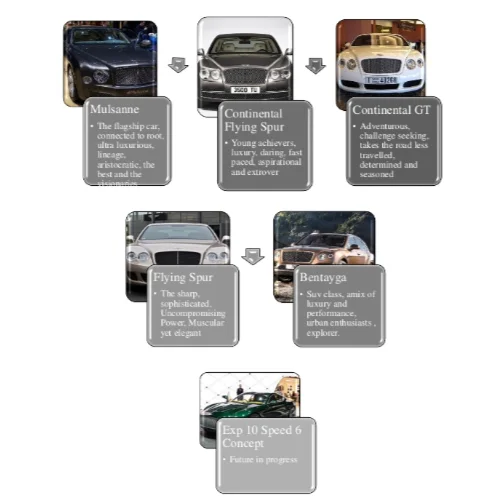
Apart from these, Bentley could as well offer limited editions of co-branded products under the differential licensing formats. These could be as the following:
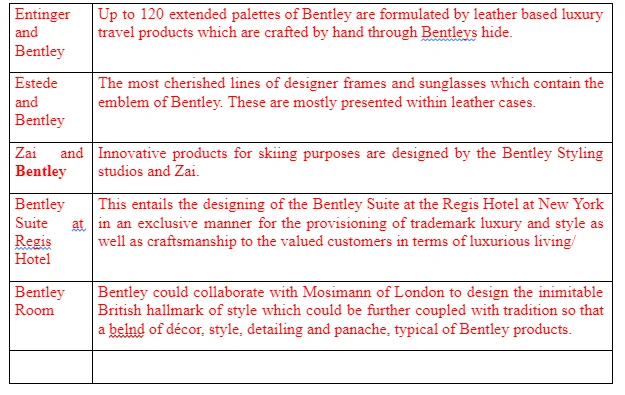
Market communication strategy
This would involve the application of personalised marketing policies. The hosting of private events would be valuable to launch the products to properly introduce the offered cars. A campaign with two phases would be required. The first phase would be associated with informing the traditional Bentley customers privately. This could be performed through personalised letters hosting information about the product version, the luxurious accessories, the unmatched quality and the price range. The second phase would involve a direct and personalised format of marketing under which the company stores would cater to singular customers per day to devote all the attention to such valuable customers specifically. Furthermore, the company could launch social dialogue and interaction avenues through social networking sites and through the official Bentley Volkswagen online information portals hosted on the company website. Furthermore, within the newly developing economies, Bentley could pursue awareness building through various event management programs such as motor exhibitions, showroom inaugurations, highlighting of exclusive craftsmanship through restrictive dealership opportunities and the venues have to be diverse as well as the economic nerve centres of the national markets as well such as Sao Paulo at Brazil, Beijing and Shanghai at China and Bangalore, Delhi and Mumbai at India. The emphasis of Bentley would have to be on the management of events, sponsorships, associations and digital promotions of the products. Bentley could as well utilise the traditional medium such as advertisements published in magazines. The social dialogues could be best communicated to the brand admirers of BML through Facebook, Twitter and YouTube. Furthermore, the sponsorship based approach of Bentley has to evolve too. This would entail the development of markets across all of the continents through consistent dealership improvement. The process would entail frequent welcoming of premier and most valued clients to participate in the sponsored golf competitions which could be organised at cross country scenarios. The award could be named as the Bentley Continental Cup. The outcomes could be off dual fold. The first would be the uniting of the golfers from different countries through enthusiastic golfing experiences and the second is the invigoration of the brand image of Bentley through selectiveness and extravagance.

Marketing budget
Hosting of events: £ 100000
Launching of social dialogues:£ 10000
Creative marketing message formulation through hiring of advertisement agencies: £20000
Advertising: £50000
Personal selling through stores: £ 40000
Public relations management: £ 10000
Evaluation
Madhani (2017) has determined that organisational marketing, for the BML, plays the vital role of communicating the manufactured product offerings to the market along with the value proposition of such offered products. Such functions are oriented towards ensuring that the potential customers could be effectively assisted in their purchase journey towards final purchase of the luxury vehicles produced by the BML. In this context, the marketing operations within the organisational structure of the BML are designed to relate to all of the other departments to communicate the key focus of production and the purpose of business decisions which are related with the mission and vision of the company under consideration. Furthermore, marketing functionalities are critical in outlining the logic behind pricing strategy formulation and supply chain management of the company. Sustaining profit margins and addition of value to the existing brand image of the BML are also incumbent upon successful marketing strategy management by the concerned organisation.
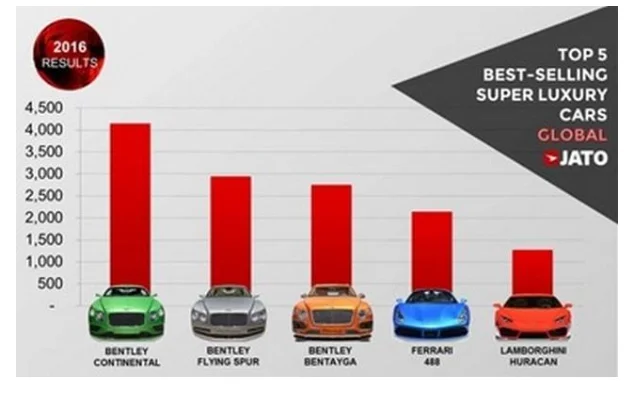
Conclusion
In this context, the study report has first been cognisant about the explanations of the role played by marketing operations for the BML and the interrelationship of the Marketing Department of the organisation with other functional components of the organisational structure. Next, the report has determined the extent to which the marketing mix (7Ps) have been utilised by the BML in order to target, capture, sustain and expand on the current luxurious vehicle markets globally as well as the outlining of the various product specifications currently offered by the company to obtain business objectives. Finally, the report has evaluated the marketing plan which has been developed by the BML marketing units.
Reference List
Kapferer, J.N. and Valette-Florence, P., 2018. The impact of brand penetration and awareness on luxury brand desirability:: A cross country analysis of the relevance of the rarity principle. Journal of Business Research, 83, pp.38-50.
Carlotto, F. and O’Leary, S., 2018. Designing the geography of luxury: Online perceptions and entrepreneurial options. Journal of Design, Business & Society, 4(2), pp.189-227.
GIACOSA, E., 2016. CHAPTER TWO THE BUSINESS OF LUXURY BRANDS: LUXURY CAR BRAND RELATIONSHIP ELISA GIACOSA, FRANCESCA CULASSO AND SANDRA MARIA CORREIA LOUREIRO. Managing Globalization: New Business Models, Strategies and Innovation, p.25.
Loureiro, S.M.C. and Kaufmann, H.R., 2016. Luxury values as drivers for affective commitment: The case of luxury car tribes. Cogent Business & Management, 3(1), p.117.
Begley, J., Collis, C. and Donnelly, T., 2015. Skills shortages: A brake on the British car industry?. Local Economy, 30(6), pp.593-608.
Noton, C., 2016. Structural estimation of price adjustment costs in the European car market. International Journal of Industrial Organization, 49, pp.105-147.
Saridakis, C. and Baltas, G., 2016. Modeling price-related consequences of the brand origin cue: An empirical examination of the automobile market. Marketing Letters, 27(1), pp.77-87.
Pardi, T., 2015. A Model to Follow? The Impact of Neoliberal Policies on the British Automobile Market and Industry. In Global Automobile Demand (pp. 37-71). Palgrave Macmillan, London.
Jedidi, H. and Heil, O., 2019, July. PRESTIGE PRICING IN MARKETS FOR LUXURY & PREMIUM PRODUCTS. In 2019 Global Fashion Management Conference at Paris (pp. 636-649).
Baltas, G. and Saridakis, C., 2010. Measuring brand equity in the car market: a hedonic price analysis. Journal of the Operational Research Society, 61(2), pp.284-293.
Rahmani, K., Emamisaleh, K. and Yadegari, R., 2015. Quality function deployment and new product development with a focus on marketing mix 4P model. Asian Journal of Research in Marketing, 4(2), pp.98-108.
- 24/7 Customer Support
- 100% Customer Satisfaction
- No Privacy Violation
- Quick Services
- Subject Experts



